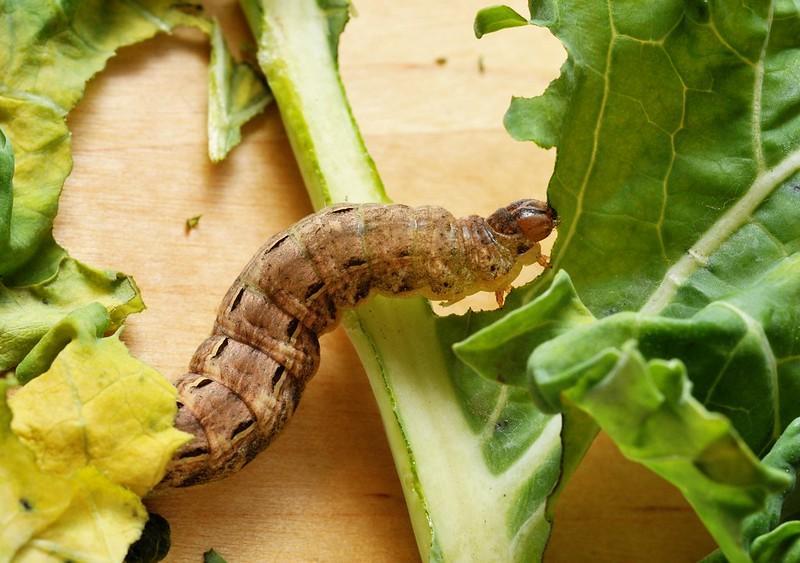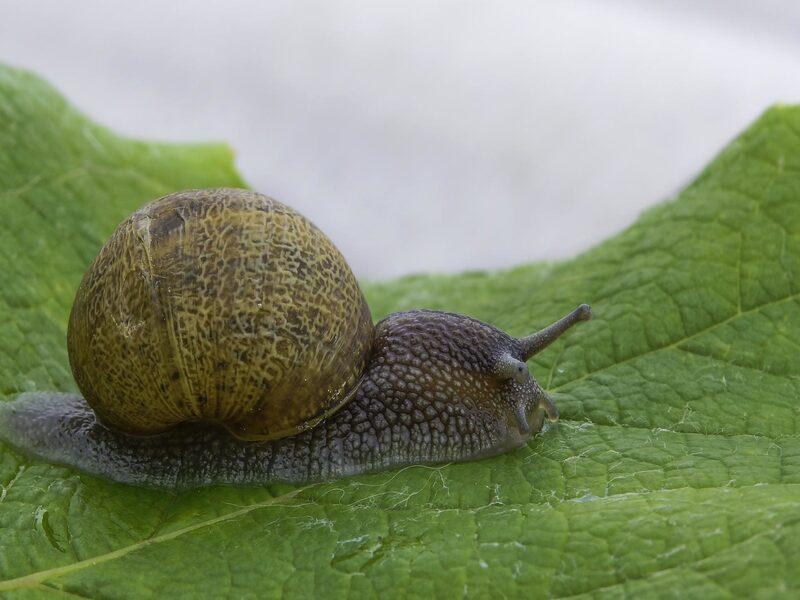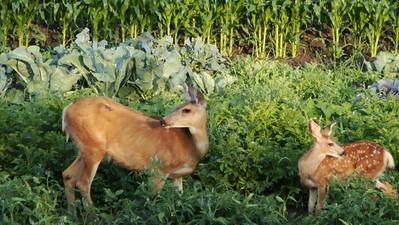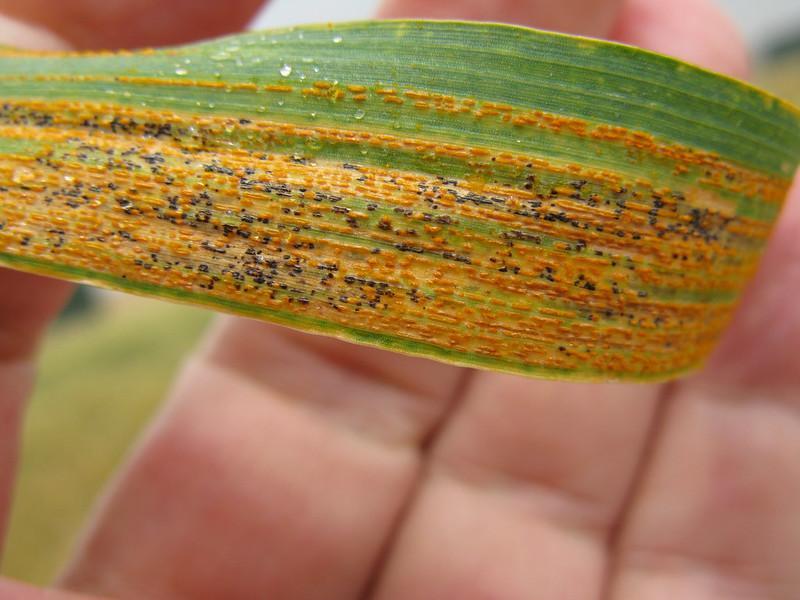Rhubarb is a low-maintenance vegetable plant that lives for a very long time. Growing rhubarb in your yard is a wonderful experience. However, unlike other vegetables, the rhubarb leaves cannot be consumed by humans as they contain oxalic acid. In this article, read and find out what is eating my rhubarb leaves.

The most likely cause of the holes in your rhubarb leaves is slugs and snails.
If consumed on a regular basis, oxalic acid in rhubarb leaves can cause very serious damage to the kidneys. Rhubarb will nevertheless make a beautiful addition to your plant collection and is still a remarkable plant with many outstanding qualities.
For instance, the oxalic acid found in rhubarb leaves is used in bleaches, tarnish removers, and, most importantly, in several insecticides. However, despite having oxalic acid-filled leaves, rhubarb is prone to attack certain pests & diseases.
So, if you grow rhubarb plants, watch out for insect pests such as leaf beetles, caterpillars, slugs, and snails that frequently attack rhubarb plants, as well as diseases such as crown rot and rust. To pinpoint what insect or disease you are dealing with, look at the harm done to your rhubarb plant.
It is recommended to take the best care of your rhubarb plants to maintain them healthy and to lessen the risk of pests damaging your plants. Read on to learn more.
Pests
Pests are the number one cause of finding holes in rhubarb leaves, and they can cause severe damage to the foliage of the rhubarb. Insect pests of rhubarb plants include Leaf Beetles, Caterpillars, Snails, and Slugs.
1. Leaf Beetles

The rhubarb curculio is one of the United States’ largest snout-nosed beetles.
The Rhubarb Curculio, sometimes known as the rhubarb weevil, is a sizable snout beetle that measures about 1/2 inch long. It has a dusting of yellow granular material on its back and is dark in color. The yellow covering of the bug peels off when touched.
As a juvenile, the curculio spends the winter on trash mounds or other safe locations close to the rhubarb plants. In contrast, the adults can be seen wandering about on rhubarb stalks and leaves around mid-May. These insects feed on the rhubarb plant, creating holes in its leaves and stem to deposit their eggs.
The damage is most evident during May and early summer when the sap starts leaking from the stem and the plant starts to rot due to their increased activity.
Control
These leaf beetles are quite easy to find due to their large size. So, one of the most effective ways to control their numbers in your garden is to manually remove them by hand. As stated earlier, they are most active in early summer, so it’d be an ideal time to do this.
Removing weeds and other wild plants growing in or close to the rhubarb planting that the beetles nest will also be beneficial. This will significantly lower the beetle population and save your rhubarb plants.
RELATED: Tan Deliciouso! 39 Different Types Of Mexican Vegetables
2. Caterpillars

In the middle of summer, the “Potato Stem Borer” may become a problem for rhubarb plants.
Among various caterpillars, the looper worm is one of the most notorious caterpillars which attacks and wreaks havoc on rhubarb plants.
The Looper worm caterpillar has a long, green-colored body, and it moves by making a looping motion, giving it its name, i.e., the looper worm. They can be spotted beneath the leaves and eat leaves and stems by drilling holes in them.
Caterpillars in small numbers do not pose any significant threat to rhubarb plants. However, a large population of caterpillars on rhubarb plants can cause severe damage to the foliage. In extreme cases, the leaves will turn pale and drop off the plant.
Control
If the infestation is on a smaller scale, caterpillars can be picked by hand from the rhubarb and thrown into a bucket of soap water to kill them off. This method is very safe as it does not include the use of insecticides which may harm the plant and environment.
However, an organic pesticide such as Bacillus Thruingiensis can be sprayed if the caterpillar infestation gets out of hand. To achieve the best possible results, you should spray the plant twice per week.
RELATED: So Darn Delicious! 13 Different Types Of American Vegetables
3. Snails & Slugs

It’s not uncommon for slugs and snails to make a meal out of rhubarb leaves.
Slugs and snails frequently attack the leaves of rhubarb plants. However, the damage they cause is only aesthetic and doesn’t leave behind any significant harm.
As such, most rhubarb plants can withstand slug and snail damage without much difficulty, and as the plant matures and the season progresses, slugs and snails will ignore the older leaves since they prefer the younger, softer leaves close to the ground.
If you spot any slimy, transparent pearl-like structures on the soil, be aware, as they can be snail or slug eggs. Take these eggs out right away.
These eggs typically hatch two weeks after being laid, and after that, they will eat your rhubarb to get food and support their growth. This is especially a problem for young plants.
Control
Keep weeds and other garden debris out of the vicinity of your rhubarb plants since they both create an excellent habitat for slugs and snails.
In small numbers, snails and slugs can be picked by hand.
However, to do so, you will have to wait for the evening, when snails and slugs are most active as the temperatures are low and aerial predators are away.
Furthermore, if you see eggs in the soil, a mixture of soap and water can be poured on them to kill the immature snails and slugs in their sleep. Besides soap, baking soda and water can also be used to destroy the eggs.
Diatomaceous earth (DE) is also effective against snails and slugs as the sharp edges of DE pierce through their bodies and cause dehydration, eventually leading to their death.
RELATED: The Dark Side of Vegetables: 13 Different Types Of Black Colored Veggies
4. Deer

It is not just insects and invertebrates that attack rhubarb plants; deer eat them too.
Eating rhubarb leaves is hazardous for both people and deer since the leaves are harmful due to the presence of oxalic acid. However, it still does not stop unaware deer from coming into your rhubarb plantings and taking a bite.
In most cases, you can easily spot the damage the deer have caused to your plants. For instance, if you find all plants in front of your rhubarbs have been pushed over, and all of the leaves on the rhubarb plant have been stripped off, the culprit is likely to be deer.
Control
Putting up a physical barrier around your plants to prevent deer from approaching them is the most effective strategy to stop deer from eating your plants.
If you do not have bird wire, you can still protect your plants by constructing a sturdy cage around them.
Diseases
In addition to insect and animal pests, diseases also pose a significant threat to the well-being of your rhubarb plants and damage rhubarb leaves and stems.
Crown rot and rust are among the most common diseases of rhubarb plants. Educating yourself on them will help you better care for your rhubarb plant.
5. Crown Rot

When the first signs of crown rot appear, it is better to uproot the afflicted plants and discard them.
Multiple fungal infections contribute to the development of crown rot in rhubarb plants. The term “crown rot” refers to the process in which the lower portion of the stem, often known as the crown, begins to decay.
Crown rot thrives under moist conditions, especially when soil becomes very wet and waterlogged. So, if there is debris at the base of the rhubarb plants, it will retain the moisture and create a favorable environment for the fungus to grow.
During the onset of crown rot, rhubarb changes its color from reddish-green to yellow. As time passes, the plant weakens, turns to mush, and dies in days.
Control
Sadly, there is no cure for crown rot. It can only be avoided by taking care of the rhubarb plants. For insurance, the plants should be watered early in the morning so that the excess water can evaporate during the day.
If your rhubarb gets affected by crown rot, dig up the entire plant and burn it. Do not throw it on the compost heap as the fungi spores might survive and infect other parts of your garden.
Moreover, try to keep the soil under the rhubarb as clean and free of debris as possible to avoid moisture retention.
6. Rust

Rust spots are most frequent on rhubarb leaves, although they can infect stems.
If you see orange-red spots on rhubarb leaves, your plant is suffering from a fungal infection called rust. Rust disease usually attacks the leaves but, in some cases, can advance to the stem. The only part that stays rust-free is the crown.
The leading causes of developing rust on your plant are moist conditions with restricted airflow. As the infection develops and progresses, orange-colored streaks appear on leaves. These streaks badly affect the leaf morphology and render it useless within days.
Control
To avoid rust, clear all the unnecessary vegetation near the rhubarb to allow maximum airflow. Sometimes, nitrogen-based fertilizers can also be the reason behind rust disease, so if rust becomes a problem in your rhubarb plantations, avoid such fertilizers.
Remove severely affected leaves and stems from the plant and destroy them. Do not put them in the compost heap as they may spread the infection to other plants.
Conclusion
Most typically, chewing insects are to blame for the holes in your rhubarb plant’s leaves, and they can be readily managed with safe and organic products such as neem oil.
Avoid applying insecticides as much as possible because they also harm beneficial insects. However, in some circumstances, such as catastrophic pest attacks, their use may become necessary.
Diseases, in addition to insect pests, are also a severe threat to the health of your rhubarb plants. The easiest way to prevent diseases is to maintain a healthy garden and take good care of your plants.
Additionally, study your plants and vegetables online. The more you know about them, the easier it will be to care for them. And that is what naturallist.com is intended for.
Frequently Asked Questions
What animal eats rhubarb leaves?
The most likely grazers are deer, who will eat rhubarb down to the ground. Usually, they only harm the rhubarb plants in the early spring when there is little other vegetation. In addition to deer, other animals that occasionally eat rhubarb leaves include bears, raccoons, skunks, squirrels, and even ravens and starlings.
How do you protect rhubarb?
To protect a well-established rhubarb plant in the soil, you should do nothing more than remove debris around it. However, young rhubarb plants should be protected in the winter with a layer of mulch to protect the crown from extreme cold and cover with a mesh or spray with neem oil to keep bugs away.
What causes holes in my rhubarb leaves?
The most frequent cause of holes in rhubarb leaves is insect pests. Additionally, a number of leaf spot infections can result in minuscule holes and tiny red or brown spots on the stems and leaves of rhubarb plants. Finally, slugs and snails are probably to blame if you see chewed-up rhubarb leaves with slime on them.
Why do you put a bucket over rhubarb?
You will have greater control over the environment in which the rhubarb grows if you cultivate it in a container such as a bucket. Additionally, covering the crowns to block light from reaching them will encourage the early development of the plants.
This process is known as “forcing rhubarb.”
Should I remove yellow leaves from rhubarb?
It is generally recommended that you remove any leaves on your rhubarb plants that have turned yellow. Taking off yellow leaves can keep your plants healthy, stop the spread of any infections or diseases, and make your garden look more organized and put together.
What does diseased rhubarb look like?
When disease strikes a rhubarb plant, it is immediately apparent. Growth slows down or becomes spindly. The leaves may turn yellow, develop spots, or show blotches.
An indication of plant disease is also physical proof of the pathogen. For instance, a fungus that produces fruiting bodies on the leaves and stems.
Sources For Further Reading
Rhubarb | Diseases and Pests, Description, Uses, Propagation. (2022). Retrieved 6 August 2022, from https://plantvillage.psu.edu/topics/rhubarb/infos
Rhubarb: The Pie Plant (David Trinklein). (2022). Retrieved 6 August 2022, from https://ipm.missouri.edu/MEG/2016/3/Rhubarb-The-Pie-Plant/
Disease Problems on Rhubarb. ISU Extension and Outreach. Retrieved 6 August 2022, from https://hortnews.extension.iastate.edu/1995/6-30-1995/rhub.html
Growing rhubarb in home gardens. (2022). Retrieved 6 August 2022, from https://extension.umn.edu/vegetables/growing-rhubarb
Editor’s Recommendations
What Is Eating My Strawberries? The Culprits & How To Control Them!
What Is Eating My Rose Leaves? Common Causes And Quick Solutions!







